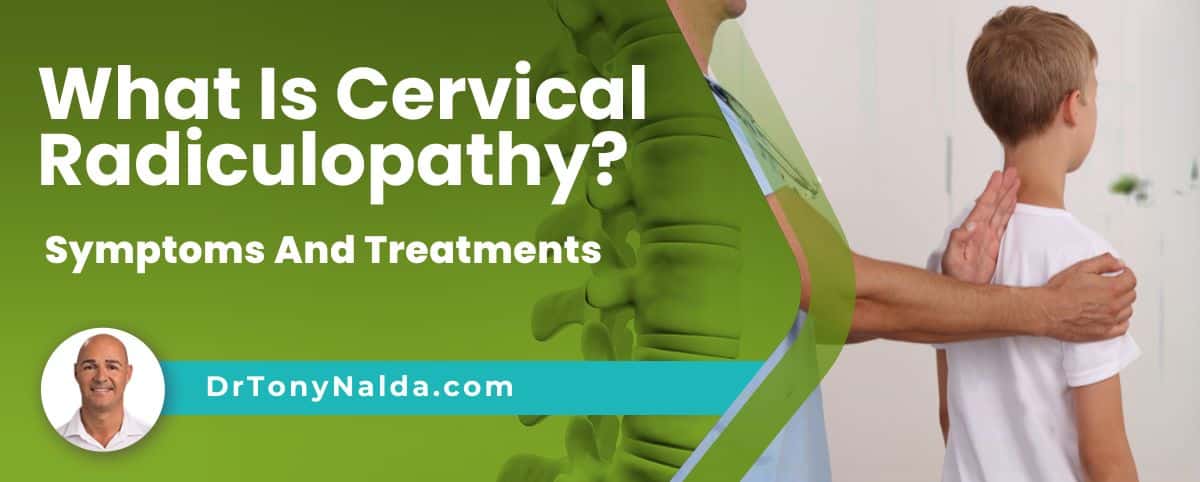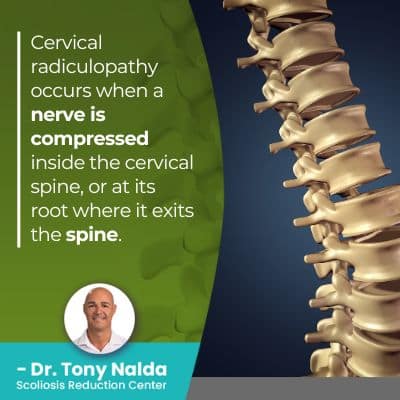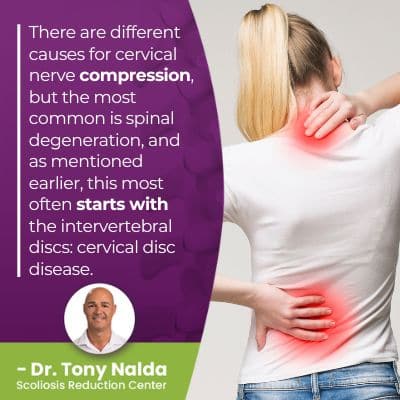What Is Cervical Radiculopathy? Symptoms And Treatments

The cervical spine contains the first seven vertebrae (bones) of the spine, and as one long structure, the health of one spinal section can affect the health of the others. Each spinal section has its own role to play in how the spine functions; continue reading to learn more about the unique roles of the cervical spine and the types of symptoms that can develop when one of its nerves is exposed to uneven pressure.
There are three main spinal sections, and the cervical spine refers to the neck. In cases of cervical radiculopathy, there is a pinched nerve root in the neck that impacts its neurological function and can cause a variety of symptoms.
Before getting to the specifics of what a cervical radiculopathy diagnosis means, let's first take a look at the spine's basic structure.
Table of Contents
Spinal Structure and Function
The spine has three main sections, each with its own natural curvature type and role to play in how the spine functions.
The cervical spine refers to the neck; the thoracic spine includes the middle/upper back, and the lumbar spine refers to the lower back.
If the spine has its natural and healthy curves in place, the cervical spine and lumbar spine feature a lordotic curve (the spine bends inwards towards the body's center), while the thoracic spine's curvature is known as kyphosis (the spine bends outwards, away from the body's center).
The spine is naturally curved at each of its main sections, and these healthy curves make the spine stronger, more flexible, and better able to adsorb and distribute mechanical stress during movement.
The spine itself consists of vertebrae (bones) that are stacked on top of one another in a straight and neutral alignment, and adjacent vertebral bodies are separated by an intervertebral disc; the spine's intervertebral discs are key to its health, strength, and function.
The discs give the spine structure (adjacent vertebrae attach to the disc in between), they combine forces to facilitate spinal flexibility and range of motion, act as the spine's shock absorbers, and provide cushioning to prevent friction generated during movement.
When the spine starts to experience degenerative changes due to natural age-related spinal degeneration, or the cumulative effect of certain lifestyle factors, it's generally the spinal discs that are the first structures to feel the effects, and this is due to the many important roles the discs play, and the fact that they don't have their own vascular supply, making disc repair and rejuvenation difficult.
The vertebrae of the spine have hollow centers, forming a tunnel through which the spinal cord, containing 31 pairs of spinal nerves, pass; together, the brain and spinal cord from the central nervous system.
The central nervous system is a vast communication network that connects the brain to the rest of the body so is involved in the function of virtually every working part and system within the body.
So now that we have a basic understanding of the spine's structure and function, let's talk about the different sections of the spine, with a focus on the cervical spine.
Sections of the Spine
As mentioned earlier, the health of each spinal section can impact the health and function of the others, and each has its own unique roles, characteristics, and challenges.
The cervical spine refers to the neck and contains the first seven vertebral bodies of the spine (C1 to C7), which we'll expand more on shortly.
The Thoracic Spine
The thoracic spine includes the middle and upper back, and this is the largest section with 12 vertebrae (T1 to T12); as the largest spinal section, it's the most rigid and stable, and the vertebrae of the thoracic spine are the only ones that attach to the ribs.
As the thoracic spine attaches to the rib cage, it provides the rib cage with stability, just as the rib cage helps stabilize the thoracic spine.
The thoracic spine and rib cage work together to protect important organs like the heart and lungs, and joint mobility in the thoracic spine allows for protection of important organs, while being moveable enough to allow for a wide range of movement, including being able to inhale and exhale deeply.
Joints in the thoracic spine allow for more rotation than in other spinal sections, but because the thoracic spine is more rigid and stable, it's the spinal section with the least amount of flexion/extension.
The Lumbar Spine
The lumbar spine extends from the base of the thoracic spine to the top of the sacral spine (bony structure at the base of the lumbar spine that attaches to the pelvis) and contains 5 vertebral bodies (L1 to L5).
The lumbar spine has important functions; it has to support the weight of the trunk and spinal sections above, and the vertebrae of the lumbar spine are larger than the rest so they can absorb forces from the head, neck, and middle body.
Like the other spinal sections, the lumbar spine has to protect the nerves within the spinal cord that runs through the lower back, at their roots where they exit the spine, and extend to different areas of the body.
The vertebrae of the lumbar spine also allow for a wide range of motion so feel the effects of bending, lifting, and twisting motions.
Because of the many roles that the lumbar spine plays in spinal function, it's particularly vulnerable to a number of conditions/issues, and it's said that everyone will experience lower back pain at some point in their lives.
Now, let's move on to our area of focus: the cervical spine.
The Cervical Spine
The cervical spine also has unique roles to play in how the spine functions and contains a vast network of complex nerves, blood vessels, and joints in a small area.
The cervical spine is both delicate and strong and acts as a bridge between the brain and the rest of the body.
The cervical spine has to be strong to support the weight of the neck and head, and it has to be flexible so it can allow for a wide range motion; heads need to turn from side to side and be able to look up and down.
The cervical spine protects the nerves within, facilitates the neck's flexibility, facilitates brain-body communication, has to support the weight of the head, and also facilitates blood flow to the brain through small holes in the vertebrae for vertebral arteries to transport blood above; these vertebral arteries are only found in the cervical spine.
When it comes to the health of the cervical spine, healthy posture is important; it's estimated that even a forward shift in posture as little as one inch increases the weight of the head on the cervical spine by approximately 10 pounds (forward head posture).
With our heavy reliance on devices and what's become known as tech neck, the cervical spine faces a lot of strain.
So what happens if the cervical spine is exposed to uneven pressure and strain?
Cervical Radiculopathy
 Cervical radiculopathy occurs when a nerve is compressed inside the cervical spine, or at its root where it exits the spine.
Cervical radiculopathy occurs when a nerve is compressed inside the cervical spine, or at its root where it exits the spine.
Compression is uneven pressure, and when a nerve is compressed, it doesn't have the space it needs to function optimally, and the uneven pressure can affect its neurological function and cause a variety of symptoms that can impact quality of life.
Symptoms of Cervical Radiculopathy
The nerves of the cervical spine facilitate brain-muscle communication so if a pinched nerve develops, it can disrupt musculoskeletal reflexes, and if a nerve root is damaged, symptoms of cervical radiculopathy can be felt anywhere along the affected nerve's pathway.
Radiculopathy can vary in severity, and while symptoms are mainly felt along the route of the damaged nerve, radicular symptoms can also be felt far from the affected nerve root in the arm, neck, shoulders, chest, upper back, and/or hand; in most cases, nerve pain and symptoms of cervical radiculopathy are felt down one side of the body.
Sensory issues are common and can include tingling and/or numbness in the fingers, hands, muscle weakness, reflex issues in the arms and legs, and disruptions to coordination.
The cervical spine is the spine's most-mobile region as it controls head movement and the neck's range of motion; the cervical spine's flexion allows for the head to be looking down (this is engaged while looking down at devices and/or during forward head posture).
Extension refers to the neck's ability to straighten out and move directly backward so the chin tilts upwards (common when performing over-head tasks), and rotation involves the cervical spine being about to turn from side to side and look over the shoulder, as one does when performing shoulder checks while driving.
Lateral flexion is engaged when the spine bends to one side, ear towards a shoulder, and some of these movements can be performed simultaneously.
In light of the many complex movements the cervical spine is capable of, some symptoms of cervical radiculopathy include disruptions to movement and range of motion; some patients might experience pain with movement, or the cervical spine can become more rigid and less moveable.
Causes of Cervical Radiculopathy
The first step to treating any spinal condition is determining its underlying cause; this is the difference between only addressing a condition's symptoms, or their underlying cause, the condition itself, for long-term sustainable treatment results.
 There are different causes for cervical nerve compression, but the most common is spinal degeneration, and as mentioned earlier, this most often starts with the intervertebral discs: cervical disc disease.
There are different causes for cervical nerve compression, but the most common is spinal degeneration, and as mentioned earlier, this most often starts with the intervertebral discs: cervical disc disease.
Spinal Degeneration
The body experiences degenerative changes as we age, and the spine is no exception.
While there is a certain amount of age-related spinal degeneration that's typical, excessive degenerative changes can become problematic and are also shaped by the cumulative effect of negative lifestyle factors: carrying excess weight, leading a sedentary lifestyle, chronic poor posture, repeatedly lifting heavy objects incorrectly, and excessive consumption of alcohol and/or smoking.
Obesity means the body's joints have more to support and this can make them degenerate faster, and as the spine's natural design is movement-based, low activity levels, often related to carrying excess weight, can impact the strength of the spine and its surrounding muscles that support and stabilize it.
When it comes to the health of the intervertebral discs, as they don't have their own vascular supply, this means there is no direct path in and out of the discs through which nutrients can pass and waste can be eliminated; increasing circulation through activity means that increased blood flow around an affected disc makes nutrients more accessible through a process similar to osmosis.
Excessive smoking and alcohol consumption can contribute to disc desiccation and the development of degenerative disc disease.
Chronic poor posture can affect the health of the spine by straining it, and its surrounding muscles, and introducing adverse spinal tension, as in cases of forward head posture.
Not understanding the ergonomics of heavy lifting can mean straining the spine and making it more vulnerable to injury and premature spinal degeneration.
So the main cause of pinched nerves in the neck is spinal degeneration that most often involves the intervertebral discs.
Cervical Disc Herniation
The discs have two main structures: a soft gel-like interior (nucleus) and a tough and durable outer layer (annulus).
If the inner nucleus starts to push outwards against the outer annulus, causing the disc to bulge outwards, it's taking up more space, and that space is taken from somewhere: often nearby nerves.
If the inner nucleus causes a tear in the outer annulus through which the nucleus pushes, this is known as disc herniation, and if the change in the disc's shape and position compresses a nearby nerve root in the cervical spine, cervical radiculopathy can become an issue.
If a disc's inner material has leaked out, it can irritate and inflame the adjacent nerve.
The most common cause of disc herniation is overuse and strenuous activity, and another spinal condition that's linked to the development of cervical radiculopathy is cervical spinal stenosis.
Cervical Foraminal Stenosis
The vertebrae have bony openings that form a spinal canal through which the spinal nerve roots pass, and if these openings become smaller, there is less space within for the nerve roots to function optimally, causing them to become irritated, inflamed, compressed, and/or impinged.
Cervical osteoarthritis and cervical degenerative disc disease are also linked with the development of bone spurs; bone spurs are bony overgrowths that often form on the edges of bones, or where bones meet in the joints.
Bone spurs in the cervical spine can cause the thickening of ligaments and/or cervical disc herniation, both of which can expose the nerve roots in the cervical foramen to uneven pressure.
Additional causes of cervical radiculopathy can include:
- Spinal fractures that cause instability
- Spondylolisthesis: condition of spinal instability where one vertebrae slips forward and down, onto the vertebral body below
- Spinal tumors: tumors pressing on the spine can cause nerve compression
- Congenital abnormalities: spinal malformations that occur in utero as the spine is forming can cause the narrowing of foramen.
It's important to determine the underlying cause of cervical nerve compression, and once it's determined, treatment plans can be customized around causation, severity, and experienced symptoms.
Cervical Radiculopathy Treatment Options
Here at the Scoliosis Reduction Center, I have experience diagnosing cervical radiculopathy and treating the condition proactively.
Treatment plans often involve combining the benefits of multiple forms of treatment, and when it comes to nonsurgical treatment of cervical radiculopathy, this can involve activity modification, rest, physical therapy, chiropractic care, and/or postural correction.
Addressing lifestyle choices that contribute to spinal degeneration can involve weight loss, physical therapy, finding a healthy and sustainable activity level, and improving posture.
A variety of therapies can help with pain relief, such as hot/cold therapy.
An ice pack and/or heated gel packs can help with neck pain, radiating pain, and mild symptoms.
Cold therapy is ideal when the nerve issues are caused by overuse as it can help reduce inflammation and pain decreases, and hot therapy can help by keeping the neck muscles loose and relaxed.
Physical therapy is particularly effective when it comes to strengthening the cervical spine's supportive muscles, and specific exercises and stretches can help temporarily relieve pressure, improve posture, and improve brain-body communication.
Chiropractic Care
When it comes to structural issues causing the cervical nerve roots to become irritated, condition-specific chiropractic care can be highly effective; this can involve a series of chiropractic techniques and manual adjustments that can address areas of vertebral subluxation exposing nerves to uneven pressure.
Manual manipulation can also increase the cervical spine's flexibility, mobility, and reduce adverse spinal tension.
Cervical traction can involve the application of a cervical collar to gently raise the head and increase the space inside the spine and between the cervical vertebrae, with a focus on narrow foramen.
In some instances, cervical radiculopathy symptoms can resolve on their own, but if left untreated and symptoms worsen, the cervical spinal nerves can become permanently damaged, and once a nerve is damaged to a certain point, it can be difficult, if not impossible, to reverse.
In most cases, an integrative approach is going to be more effective than a single form of treatment because nerve issues can have a number of effects, best addressed by different types of treatment applied simultaneously.
Conclusion
People diagnosed with cervical radiculopathy can experience varying levels of pain and a variety of symptoms that can involve both movement and sensation.
The cervical spine contains the first seven vertebrae and starts at the base of the skull and extends to the upper back, where the thoracic spine starts.
The cervical spine is important not only because it controls how the head moves, but also because it has to support the weight of the head and facilitates brain-body communication.
When cervical radiculopathy occurs, one or more spinal nerves in the cervical spine are being exposed to uneven pressure, and when a nerve root is compressed, it can cause pain, muscle weakness, and disrupt the neck's range of motion.
There are different causes of nerve compression but the most common is spinal degeneration that often starts with the intervertebral discs; additional causes can include disc herniation, injury, stenosis and spondylolisthesis.
A recent cervical radiculopathy diagnosis means its underlying cause needs to be determined and addressed; treatment plans are customized and shaped around causation, severity, and experienced symptoms.
While some instances of nerve compression will resolve on their own, many cases require a proactive treatment approach that works to remove pressure on the affected nerve root, and nonsurgical treatment of cervical radiculopathy can include a variety of therapies, lifestyle guidance, postural correction, physical therapy, and chiropractic care.
If cervical radiculopathy is left untreated and progresses, nerve damage can become permanent, hence the importance of proactive treatment.
Here at the Center, my patients with cervical radiculopathy benefit from a proactive conservative treatment approach that has the goal of helping patients avoid invasive surgical procedures.
Dr. Tony Nalda
DOCTOR OF CHIROPRACTIC
After receiving an undergraduate degree in psychology and his Doctorate of Chiropractic from Life University, Dr. Nalda settled in Celebration, Florida and proceeded to build one of Central Florida’s most successful chiropractic clinics.
His experience with patients suffering from scoliosis, and the confusion and frustration they faced, led him to seek a specialty in scoliosis care. In 2006 he completed his Intensive Care Certification from CLEAR Institute, a leading scoliosis educational and certification center.
About Dr. Tony Nalda
 Ready to explore scoliosis treatment? Contact Us Now
Ready to explore scoliosis treatment? Contact Us Now





